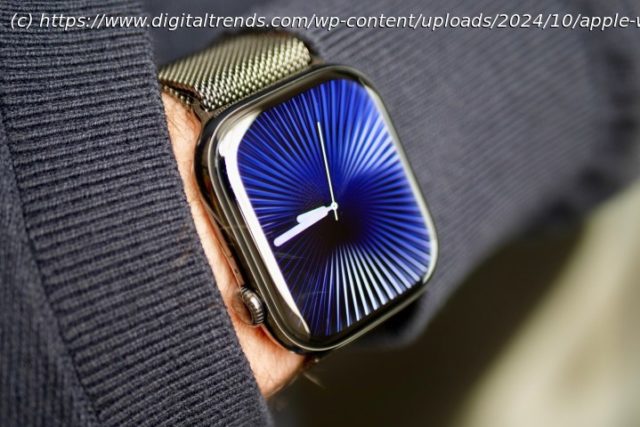The Apple Watch Series 10 has arrived to challenge Samsung’s Galaxy Watch 7. How do these two flagship smartwatches compare?
The Apple Watch Series 10 has arrived with a thinner and lighter design and an even larger screen, once again shaking up the smartwatch world. Apple’s smartwatches have been solid wearables for so long that they’ve become the standard against which most competing Android smartwatches are measured, and this year’s Samsung Galaxy Watch 7 is no exception.
Samsung has often beaten Apple to the punch lately in terms of offering new health features, even if they’re not always fully baked at release, but that’s likely only because it can read the writing on the wall. Apple matches most of what Samsung comes up with only a few weeks later, keeping the two wearables neck and neck at most things. Apple and Samsung may be able to measure the same metrics, but each takes its own approach to how it presents and interprets them — and those approaches are as different as the designs of the wearables themselves.
The choice between the Apple Watch Series 10 and Galaxy Watch 7 is more likely to be dictated by whatever smartphone you’re already using — you can’t use an Apple Watch with an Android phone and vice versa — but it’s always interesting to explore how the other side lives. Plus, the Apple Watch Series 10 and Galaxy Watch 7 each have enough unique features to be a determining factor for anyone thinking about switching platforms. Let’s take a look at how this year’s two flagship smartwatches measure up.Apple Watch Series 10 vs. Samsung Galaxy Watch 7Apple Watch Series 10 vs. Samsung Galaxy Watch 7: design
Anyone who has ever seen an Apple Watch should be familiar with the Apple Watch Series 10 at first glance, but closer examination will show that Apple has made some subtle, but significant changes to this year’s model.
While the overall aesthetic remains the same, the Apple Watch Series 10 gets both a larger screen and a thinner body. The screen on the largest 46mm model jumps to a 1.96-inch diagonal, making it slightly larger than the display on the bulkier app Apple Watch Ultra 2. However, the design gets even more svelte, shaving a millimeter off the thickness. That might not sound like much, but it makes a huge difference for something you wear on your wrist all day, as does the four-gram weight reduction that comes with it. That works out to a 10% reduction in both thickness and weight.
By comparison, the Galaxy Watch 7 doesn’t change at all on the outside compared to its predecessor, but we think that’s a good thing as it signals that Samsung has hit its design stride. Apple’s smartwatches have become iconic over their 10-year lifespan, while Samsung has struggled to find its stylistic niche. It also didn’t need to shed any thickness or weight, as it was already thinner and lighter than last year’s Apple Watch Series 9; Apple had to slim down its wearable to match Samsung’s already thinner design
Nevertheless, the Apple Watch Series 10 and Galaxy Watch 7 couldn’t be more polarized in their designs. While Samsung leaned a bit into Apple’s style with its new Galaxy Watch Ultra, the Galaxy Watch 7 remains refreshingly different, with an attractive round design that sets it apart from Apple’s squarish look. While platform compatibility means that style may not be the most essential factor in choosing between these two wearables, that’s a shame as we really think it makes a difference.
The Galaxy Watch 7 retains its two-button side controls. There’s no Digital Crown here like you’ll find on the Apple Watch, nor do we get the fun physically rotating bezel of the Galaxy Watch 6 Classic. Instead, you get a touchscreen virtual bezel to help you navigate and scroll quickly through longer lists.
This year, the Apple Watch Series 10 replaces Apple’s traditional matte black aluminum finish with a sleek new Jet Black finish. However, it lacks the more colorful options of prior models, with only rose gold and silver alternatives. A higher-end version uses a titanium casing and comes in slate, gold, and natural shades. The Galaxy Watch 7’s case uses Samsung’s Armor Aluminum, with green, silver, and cream colors — although the latter two are limited to specific sizes.
Samsung uses sapphire crystal on all Galaxy Watch 7 models, which should offer more scratch resistance over the aluminum Apple Watch Series 10, which uses Apple’s Ion-X glass formulation. Apple reserves sapphire glass for its pricier titanium Series 10 models. The Apple Watch Series 10 and Galaxy Watch 7 provide 5ATM and IP68 dust and water resistance, respectively, plus a MIL-STD-810H rating for protection against outdoor elements.
At the end of the day, design is subjective, and these two smartwatches couldn’t be more different, so we’re calling this one a tie.
Winner: TieApple Watch Series 10 vs. Samsung Galaxy Watch 7: display
The different styles of the Apple Watch Series 10 and Galaxy Watch 7 also results in the starkest contrast between their displays: the shape.
The Apple Watch Series 10 maintains the square design that’s been the mainstay of Apple’s wearables since their inception, while Samsung opts for a more traditional watch-like circular design. This makes it difficult to compare the screen dimensions on an even footing. For instance, while the 1.96-inch (49.8mm) diagonal of the Apple Watch Series 10 may cause it to seem as if it has a much larger display than the 1.5-inch (38.1mm) diameter of the Galaxy Watch 7, the display area on Apple’s wearable is only 80mm greater than that of the Galaxy Watch 7 — or slightly under a single square centimeter.
Both watches have similar resolutions — 416 x 496 pixels for the Apple Watch Series 10 and 480 x 480 pixels across the center of the Galaxy Watch 7 — which work out to densities of 330 pixels per inch (ppi) and 320 ppi, respectively.
This means both screens should be equally crisp. The Apple Watch Series 10 retains the same 2,000 nits of peak brightness as its predecessor. While Samsung hasn’t offered up a brightness spec for the AMOLED panel on its Galaxy Watch 7, the consensus is that it’s essentially the same 2,000-nit screen as the one for last year’s Galaxy Watch 6. While neither reaches the 3,00-nit level of their respective Ultra counterparts, we had no problems seeing the display on either under even the brightest conditions we encountered.
However, Apple has another useful trick up its sleeve for this year’s model. The Apple Watch Series 10 has a new wide-angle OLED display, a technology pioneered by Apple for its wearable that it claims makes the screen up to 40% brighter when viewed at all angles. That’s an important bonus for a device that you’re more likely to be looking at from an off-axis angle. Both wearables have great and bright screens, but those better viewing angles give the Apple Watch the edge here.
Winner: Apple Watch Series 10Apple Watch Series 10 vs. Samsung Galaxy Watch 7: performance
The Apple Watch Series 10 gets the expected boost from Apple’s latest S10 chip, but oddly, Apple didn’t have as much to say about that new chip this year. That’s likely because it’s merely a repackaged version of last year’s S9 chip. Apple increments its S-series chip names with each year’s Apple Watch, but only upgrades the underlying silicon every two or three generations. The S9 and S10 are believed to use the same T8310 architecture.
That means we shouldn’t expect significant performance bumps over last year’s Apple Watch Series 9 (or Apple Watch Ultra 2). However, that’s not surprising since those older models have received many of the same features introduced on the Series 10. It’s also largely irrelevant as we’ve never had performance issues with any Apple Watch models we’ve reviewed, and that’s not about to start with the Apple Watch Series 10, which handled everything we threw at it with aplomb.
On the other hand, some of Samsung’s previous Galaxy Watch models have been on the sluggish side when compared to the “gold standard” of the Apple Watch. That changes with this year’s Galaxy Watch 7, which can finally hold its own. That comes courtesy of the new five-core Exynos W1000 chip in this year’s model, which provides a threefold boost in performance over the Exynos W930. It’s a noticeable boost that makes navigating through the Galaxy Watch 7 as smooth as glass; apps open almost instantly, there’s no hint of lagginess, and notifications come in immediately. The Apple Watch Series 10 may still come out slightly ahead, but we don’t think there’s a difference here anyone will notice unless you’re comparing them side by side with a stopwatch. Nevertheless, Apple’s S10 chip is built on a lineup of solid performers.
Winner: Apple Watch Series 10Apple Watch Series 10 vs. Samsung Galaxy Watch 7: software and features
The Apple Watch Series 10 runs Apple’s latest watchOS 11 operating system and requires an iPhone running iOS 18 or later.






